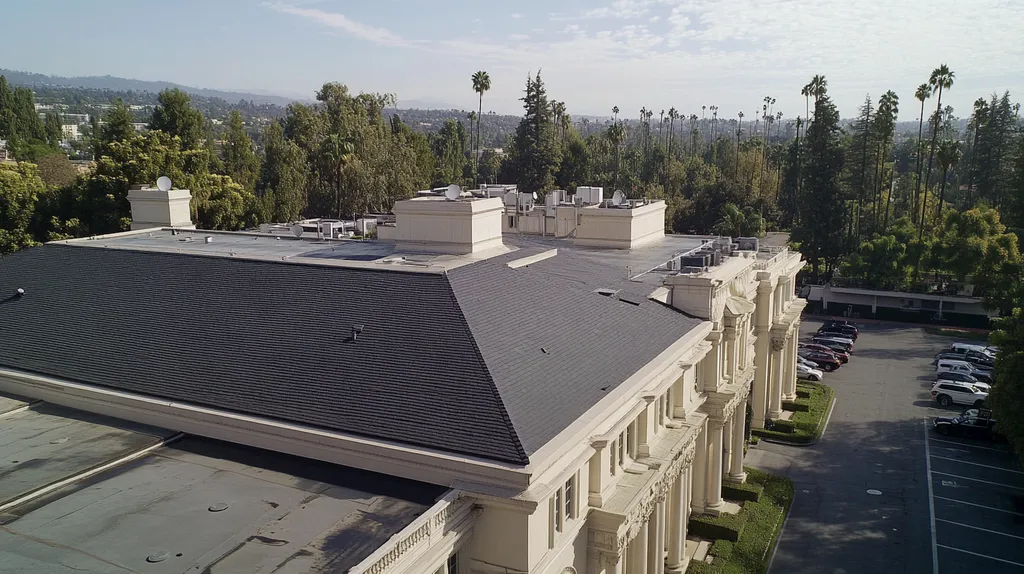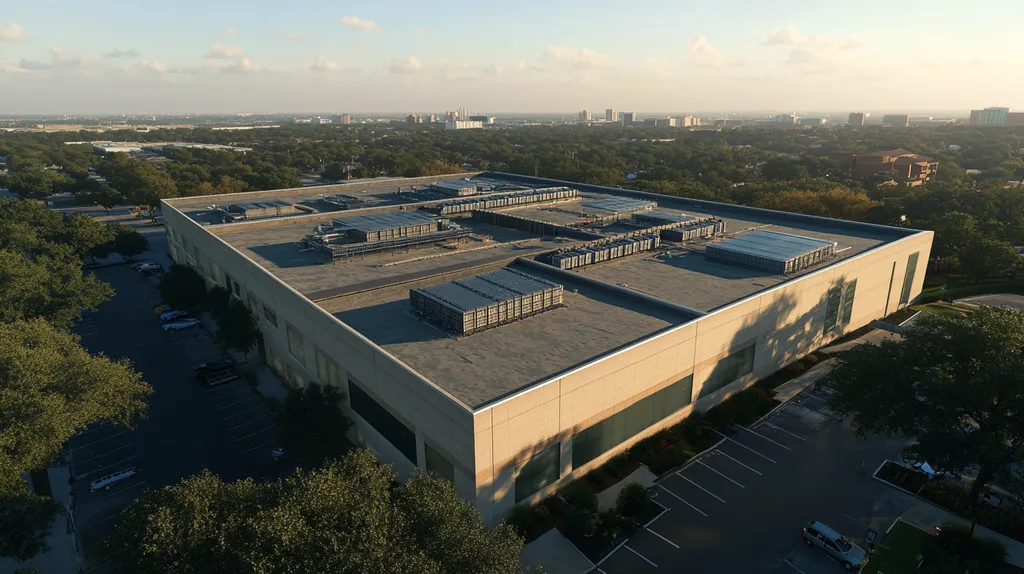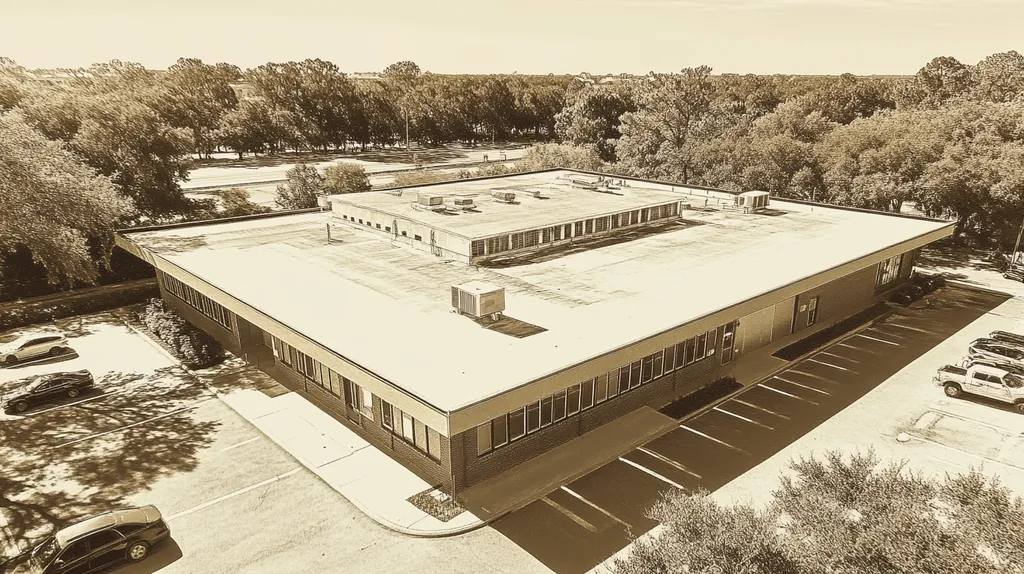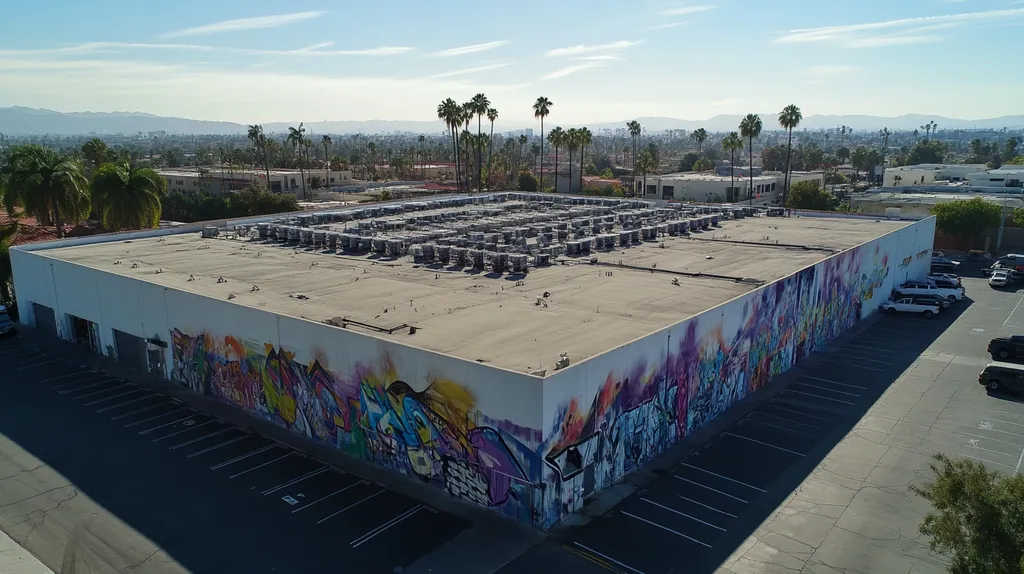Commercial property owners face mounting pressure as energy costs continue to rise, with cooling expenses now accounting for up to 15% of total building energy use. The U.S. Department of Energy reports that reflective roof coatings can reduce peak cooling demand by up to 15-25% in commercial buildings.
For facility managers seeking actionable solutions, understanding the impact of reflective coatings has become critical. These coatings serve as a first line of defense against solar heat gain while providing significant returns on investment.
This comprehensive guide examines performance factors, financial considerations, compliance requirements, risk management strategies, and operational procedures that property managers need to maximize roofing energy efficiency.
SECTION 1: PERFORMANCE FACTORS
In the competitive commercial sector, enhancing roofing energy efficiency has become a vital necessity. With roofs often absorbing excessive sunlight, they contribute significantly to rising cooling expenses. The U.S. Department of Energy indicates that reflective roofing materials can lead to cooling energy savings of as much as 20%. This section will delve into the importance of roof reflectivity, effective heat gain reduction strategies, and approaches to enhance thermal comfort.
Roof Reflectivity and Energy Savings
Roof reflectivity is a key component of energy efficiency in commercial buildings. By using reflective roofing materials, facilities can deflect sunlight and reduce heat absorption during hot months. This helps to lessen dependence on air conditioning systems, leading to significant energy cost reductions.
For example, while a gray asphalt roof may have a solar reflectance index (SRI) as low as 0.20, a white reflective membrane can achieve an impressive SRI of 0.90. This stark contrast not only translates to lower energy consumption but also assists facility managers in achieving their sustainability goals.
Moreover, many local governments offer tax credits and rebates for installing reflective roofs. By opting for reflective coatings or materials, facility managers can capitalize on these financial incentives while enhancing the efficiency of their buildings.
Ultimately, increased roof reflectivity supports energy savings and contributes to a healthier environment by mitigating the urban heat island effect. Facilities must prioritize this critical aspect of roof design to stay competitive.
Key Action Items
Heat Gain Reduction Strategies
Minimizing heat gain is crucial for improving energy efficiency in commercial roofing systems. One effective approach is applying high-performance reflective coatings that are specifically designed to limit heat absorption while extending the life of the roof.
Another strategy is to install insulation layers beneath reflective membranes. Adding rigid insulation can create a thermal barrier that keeps indoor temperatures cooler during peak heat periods.
Additionally, green roofs present an innovative solution. These living roofs offer not just visual appeal; they enhance insulation and absorb rainwater, resulting in noteworthy reductions in heat gain.
Regular maintenance is vital as well. Keeping roofs clear of debris ensures that reflective materials function at their best, while scheduled inspections help to identify potential issues before they develop into costly problems.
Key Action Items
Thermal Comfort Enhancement
Enhancing thermal comfort is essential for the well-being of building occupants and can significantly boost productivity. Creating a cooler indoor environment not only increases comfort but also proves to be a smart investment for facility managers.
Reflective roof coatings aid in stabilizing indoor temperatures, fostering a more consistent climate within the building. This stability can lead to heightened employee satisfaction and lowered absenteeism rates.
Furthermore, integrating proper ventilation with reflective roofs can further improve comfort. Features like operable windows combined with reflective surfaces enhance airflow and temperature control.
Engaging building occupants in monitoring indoor climate conditions can ensure a balanced approach. Investing in smart building technologies to track and optimize heating and cooling is another effective way to maintain thermal efficiency.
Key Action Items
SECTION 2: FINANCIAL CONSIDERATIONS
As energy costs continue to climb, facility managers are being pressured to rethink their roofing choices. Reflective coatings can drastically lower energy consumption, leading to significant savings over time. Understanding these financial aspects enables property owners to evaluate the true value of such coatings as a strategic investment. This section covers essential comparisons between initial costs and long-term savings, energy consumption reduction, and potential rebates and tax credits.
Initial Cost vs. Long-Term Savings
Investing in reflective coatings may involve higher initial costs, which can be off-putting for some facility managers. However, these upfront expenses are often balanced out by substantial long-term savings stemming from decreased energy usage. Many properties see a return on investment in just a few years as utility bills decrease.
Reflective coatings can lower roof surface temperatures significantly, alleviating the stress on HVAC systems. This thermal load reduction not only draws down cooling costs but can also prolong the lifespan of the roofing system, preventing costly repairs and replacements down the line.
It is imperative that facility managers conduct a cost analysis that includes projected energy savings over time. By measuring these long-term benefits against the initial investment, they can make informed decisions that enhance their building’s financial performance.
Key Action Items
Energy Consumption Reduction
Energy efficiency is crucial for controlling operational expenses in commercial properties. Reflective coatings help minimize the heat absorbed by rooftops, directly reducing the reliance on air conditioning. With decreased energy usage for climate control, facilities can realize significant reductions in overall energy consumption.
Buildings outfitted with reflective roofs can manage indoor temperatures more effectively, resulting in greater comfort and productivity for occupants. As energy regulations become stricter, having an energy-efficient roof is essential not just for operational advantages but also for regulatory compliance.
Additionally, lower energy consumption contributes to a smaller carbon footprint, aligning with the sustainability goals many organizations prioritize today. Thus, investing in energy-saving technologies reinforces a facility’s standing as an environmentally conscious player in the market.
Key Action Items
Rebates and Tax Credits Availability
Beyond the long-term savings from lowered energy costs, facility managers should investigate available rebates and tax credits for reflective roofing systems. Many local and state governments provide financial incentives to encourage energy-efficient upgrades, which can greatly mitigate initial installation expenses.
These incentives can take various forms, often linking directly to energy savings generated by installing reflective coatings. By leveraging these programs, property owners can further decrease their financial commitment, making energy-efficient solutions increasingly attainable.
Tax credits are also potential financial benefits that facility managers can harness. Specific green building initiatives may qualify for federal or state tax deductions, which effectively lower the total investment cost in reflective roofing solutions.
Key Action Items
SECTION 3: COMPLIANCE REQUIREMENTS
With growing emphasis on energy efficiency, facility managers face an evolving landscape of compliance requirements. Failing to adhere to these regulations can result in costly fines and lost savings opportunities. Reflective coatings play a pivotal role in enhancing energy efficiency, underscoring the need for property owners to grasp relevant building codes, environmental laws, and green initiative incentives. This section will clarify the compliance factors that affect roofing choices.
Building Code Standards and Compliance
Adhering to local and national building codes is critical for any roofing initiative. These codes set minimum energy performance standards for commercial roofs, such as those outlined in the International Energy Conservation Code (IECC), which emphasizes the advantages of reflective roofing materials for reducing heat absorption.
Facility managers must keep abreast of these codes to prevent penalties and ensure that installations are compliant, which also opens the door to potential energy savings. Reflective coatings that meet these standards not only enhance efficiency but also ensure the safety of building occupants.
In certain regions, specific regulations incentivize the use of reflective coatings, particularly in hotter climates. Familiarity with local stipulations enables better decision-making for facility managers. Regular inspections and proper documentation are essential tasks to maintain compliance over time.
Key Action Items
Environmental Regulations and Impact
Environmental regulations increasingly shape practices in commercial roofing. Federal and state agencies enforce rules designed to minimize the environmental impact of building materials, including roofs. Reflective coatings, which lower energy consumption, are often favored by regulators.
Facility managers must understand these regulations to align projects with sustainability objectives. For example, using solvent-free reflective coatings helps meet the air quality standards established by the Environmental Protection Agency (EPA).
Proactively choosing reflective coatings not only ensures compliance but may unlock potential tax credits or rebates in many jurisdictions. Complying with environmental regulations mitigates legal risks and enhances a facility’s reputation for sustainability.
Key Action Items
LEED Certification and Green Initiatives
LEED (Leadership in Energy and Environmental Design) certification is a valuable accolade that enhances a facility’s market appeal. Achieving LEED certification requires adherence to strict energy efficiency criteria, often necessitating the use of reflective roofing materials.
Reflective coatings can earn points in several LEED categories, such as Energy and Atmosphere and Sustainable Sites. High solar reflectance roofing helps mitigate the urban heat island effect, boosting sustainability credentials.
In addition, obtaining LEED certification can yield long-term financial gains, including lower energy costs and improved productivity. As organizations seek to enhance their LEED scores, integrating reflective coatings becomes an effective strategy for compliance and overall improvement.
Key Action Items
SECTION 4: RISK MANAGEMENT
In commercial roofing, effective risk management is critical to avoid expensive failures and prolong roof life. A staggering 80% of commercial roofs fail prematurely, often due to inadequate maintenance and design flaws. Facility managers must tackle numerous challenges such as weather-related damage and continuous upkeep. By understanding these risks and implementing proactive strategies, property owners can enhance the durability and performance of reflective coatings, leading to improved energy efficiency.
Roof Failure Risk Mitigation
Mitigating the risk of roof failure starts with a thorough assessment of the roof’s condition and design. Many commercial buildings still operate with outdated materials that lack the resilience needed to withstand harsh weather. For example, poor drainage systems can create areas of water pooling, leading to leaks and structural damage.
Applying reflective coatings can significantly strengthen the roof’s defenses. These coatings manage temperature effectively and shield against harmful UV exposure. By refreshing roofs with these coatings, property owners can extend the lifespan and performance of existing structures.
Regular inspections are vital as well. Facility managers should plan maintenance checks at least twice a year to identify potential problems early. This proactive strategy allows for minor repairs before they escalate into major, costly issues.
Key Action Items
Weather Resistance and Durability
Extreme weather can severely damage commercial roofs, especially those lacking sufficient protection. Reflective coatings serve as a barrier against intense sunlight, heavy rains, and temperature fluctuations. Buildings in areas prone to severe weather can see substantial benefits from these durable coatings.
For instance, reflective coatings minimize thermal expansion and contraction, which can cause cracks and weaken structural integrity. By maintaining a stable temperature, these coatings enhance the roof’s ability to endure harsh conditions without succumbing to damage.
Additionally, selecting high-quality materials for reflective coatings significantly influences long-term durability. Products tailored for specific climates provide better resistance to environmental stressors, ensuring peace of mind for property owners.
Key Action Items
Maintenance and Repair Strategies
Effective maintenance and repair strategies are crucial for maintaining roof energy efficiency. A neglected roof can quickly diminish the benefits of reflective coatings. Establishing a routine maintenance schedule is essential for pinpointing and addressing early signs of wear.
Regular cleaning is vital for ensuring that reflective surfaces operate at peak efficiency. Debris accumulation can obstruct the reflective properties of the roof, thereby affecting overall energy performance. Facility managers should make cleaning a top priority in their maintenance plan.
Additionally, prompt repairs of minor damages, such as blisters or tears, can avert more extensive issues. Scheduling annual expert inspections allows for evaluation of both the roof’s integrity and reflective properties, boosting overall performance.
Key Action Items
SECTION 5: OPERATIONAL PROCEDURES
Implementing reflective coatings on commercial roofs is not just a best practice; it is an essential operational mandate. Overlooking proper procedures can lead to significant inefficiencies and escalating energy costs. For instance, a hastily applied coating may wear off quickly, undermining energy-saving benefits. Facility managers need to master the application process, choose high-quality materials, and maintain ongoing inspections to maximize the life and performance of reflective coatings. This section highlights these critical procedures.
Application and Installation Processes
The success of reflective coatings hinges on meticulous application processes. A clean, dry surface is a prerequisite to ensure optimal adhesion. This preparation includes removing dirt, debris, and any old coatings that could hinder the new application.
Temperature and humidity significantly influence the effectiveness of the application. Ideal conditions occur during mild weather, as extreme conditions can compromise the coating’s performance. Facility managers must schedule installations to align with favorable weather.
Utilizing trained professionals is paramount. Skilled applicators are adept in material properties and can avert common problems such as bubbling or uneven coverage. Investing in experienced teams is key to achieving durable coatings.
Key Action Items
Coating Selection and Material Quality
Choosing the right reflective coating material is vital, as all coatings do not deliver the same performance. Facility managers should prioritize high-albedo coatings that effectively reflect more sunlight, leading to decreased roof temperatures.
It’s also crucial to consider local climate conditions when selecting coatings. Coatings suitable for hot, sunny areas differ from those designed for humid or freeze-thaw environments. Tailoring selections enhances both durability and energy efficiency.
While premium materials may seem like a higher initial investment, their longevity often offsets more frequent replacement costs. Investing in quality yields significant long-term savings and reduced maintenance needs.
Key Action Items
Ongoing Maintenance and Inspection
Regular maintenance and inspections are essential to prolonging the life of reflective roofs. Facility managers should initiate systematic checks to identify potential damage like cracks or peeling promptly.
Conducting annual inspections is especially critical post severe weather events, as roofs frequently endure hidden damage that can exacerbate over time. Regular upkeep maintains the roof’s reflective ability and avoids costly repairs.
Routine cleaning is crucial too; debris accumulation can obstruct reflective properties, undermining energy efficiency. Establishing a consistent cleaning schedule helps ensure optimal performance for the full lifespan of the coating.
Key Action Items
SECTION 5: OPERATIONAL PROCEDURES
Implementing reflective coatings on commercial roofs requires precise operational procedures to ensure efficiency and cost-effectiveness. Overlooking these steps can result in wasted resources and higher energy expenses. For example, an improperly applied coating can deteriorate quickly, negating the expected energy savings. Facility managers must grasp the nuances of the application process, select high-quality materials, and engage in continual maintenance to extend the lifespan and performance of reflective coatings. This section will explore these essential procedures.
Application and Installation Processes
The application process for reflective coatings is vital for achieving optimal energy performance. A clean, dry surface is required to ensure effective adhesion, which involves removing dirt, debris, and any previous coatings that may hinder the new layer’s application.
Temperature and humidity are significant factors during installation. Ideal conditions exist during mild weather because extreme conditions can compromise the coating’s efficacy. Facility managers should schedule installations accordingly to avoid unfavorable weather.
Employing trained professionals is essential for successful application. Skilled installers understand the properties of materials and can prevent common problems such as bubbling or uneven coverage. Investing in experienced applicators is crucial for achieving durable and efficient coatings.
Additionally, strict adherence to manufacturer guidelines is mandatory. Each product has specific application instructions regarding thickness and curing time, which are essential for maintaining energy efficiency (source: U.S. Department of Energy).
Key Action Items
Coating Selection and Material Quality
Choosing the right coating material is just as crucial as the application process itself. Not all reflective coatings provide the same level of performance; quality variations can significantly impact efficiency. Facility managers should prioritize high-albedo coatings that reflect more sunlight, effectively reducing roof temperatures.
Understanding local climate conditions is also key in selecting appropriate coatings. Coatings suited for sunny environments may differ considerably from those designed for humid or freeze-thaw regions. Tailored selections enhance both durability and energy efficiency.
While premium materials may entail higher initial costs, their long-term benefits can outweigh these upfront expenses. High-quality coatings generally last longer, reducing the need for frequent replacements and maintenance.
Researching product warranties and performance certifications is vital. Many reputable brands offer robust warranties and documented testing results, reinforcing claims of durability and energy efficiency.
Key Action Items
Ongoing Maintenance and Inspection
Regular maintenance and inspections are essential for maximizing the lifespan of reflective roofing systems. After installation, facility managers should schedule routine checks to identify potential damages like cracks or peeling as early as possible.
Annual inspections are especially important after severe weather events. Roofs can incur hidden damage that may lead to larger issues if not addressed swiftly. Consistent maintenance ensures roofs retain their reflective properties and helps prevent costly repairs.
Periodic cleaning is critical as well. Dust, debris, or algae can obstruct the reflective capabilities of coatings, compromising energy efficiency. Establishing a consistent cleaning regimen will help sustain optimal performance throughout the coating’s lifespan.
Lastly, property managers should maintain detailed records of all maintenance activities. Thorough documentation aids in identifying trends over time and supports informed decisions regarding roofing performance and future needs.
Key Action Items
Looking Ahead
With energy costs projected to rise 15% annually through 2025, facility managers cannot afford to delay implementing reflective roof coatings. Studies show these solutions reduce cooling costs by up to 25% while extending roof life by 5-10 years.
The evidence is clear: reflective coatings deliver measurable returns through reduced energy consumption, extended roof lifespans, and enhanced occupant comfort. Top-performing facilities are already realizing these benefits.
Success requires following established best practices for material selection, professional installation, and ongoing maintenance. Property owners who act now position themselves to capture maximum energy savings while meeting increasingly strict efficiency regulations.
The question is no longer whether to implement reflective coatings, but rather how quickly organizations can deploy these proven solutions to start reducing costs and improving building performance.
FREQUENTLY ASKED QUESTIONS
Q. How does a commercial roof’s reflectivity improve energy efficiency?
A. A commercial roof’s reflectivity reduces heat absorption, leading to lower cooling costs. This allows property managers to significantly decrease energy expenses by relying less on air conditioning systems during hot months.
Q. What are the long-term savings of reflective coatings on an industrial roof?
A. Reflective coatings on an industrial roof provide substantial long-term savings through reduced energy usage. Initially higher costs are often offset by decreased utility bills over time, yielding attractive returns on investment.
Q. Which compliance requirements apply to commercial roofs?
A. Commercial roofs must adhere to local and national building codes that set minimum energy performance standards. Meeting these requirements not only ensures compliance but also enhances a building’s efficiency and safety.
Q. How can I mitigate the risk of commercial roof failures?
A. To mitigate roof failure risks, conduct regular inspections and apply reflective coatings. Regular maintenance, including checking drainage systems, will prevent minor issues from escalating into costly repairs.
Q. What are essential operational procedures for applying reflective coatings?
A. Essential procedures include ensuring a clean surface, hiring certified professionals, and adhering to manufacturer guidelines. These steps help maximize the coatings’ effectiveness and longevity on a commercial roof.
Q. Which materials should I consider for reflective coatings?
A. Consider high-albedo materials that effectively reflect sunlight. Additionally, select coatings tailored to your local climate for improved performance and durability, ensuring they withstand environmental stressors effectively.
Q. Can reflective coatings qualify for tax credits and rebates?
A. Yes, reflective coatings can often qualify for tax credits and rebates. Many local and state programs encourage energy-efficient upgrades, making them accessible and financially beneficial for property owners.











